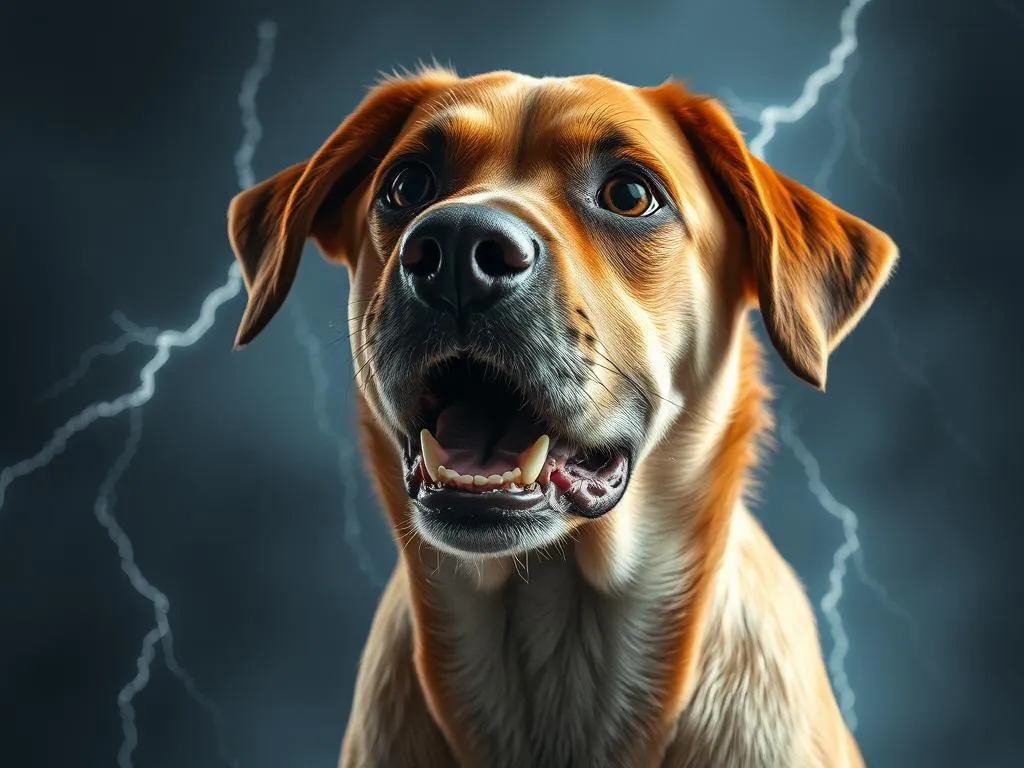
Dogs are cherished members of our families, and their health care is paramount to ensuring they lead happy, fulfilling lives. One common issue that many dog owners face is when their pets become scared of thunder. Understanding this fear is crucial, as it can significantly impact a dog’s mental and physical well-being. In this article, we will explore thunder phobia in dogs, its causes, signs, impacts, management strategies, training techniques, personal experiences, and resources for dog owners.
Understanding Thunder Phobia in Dogs
Definition of Thunder Phobia
Thunder phobia is an intense fear of thunder and associated weather phenomena. Unlike general anxiety during storms, a phobia is an irrational fear response that can lead to extreme distress. Symptoms can manifest in various ways, including:
- Behavioral signs: Hiding, barking, whining, or attempts to escape.
- Physical signs: Shaking, drooling, panting, or pacing.
- Duration and frequency: Phobic reactions can vary significantly; some dogs may experience anxiety only during specific weather events, while others may react to any loud noise.
Causes of Thunder Phobia
Thunder phobia can stem from various factors, including:
- Genetic predisposition: Certain breeds, such as Border Collies, German Shepherds, and Cocker Spaniels, are more prone to anxiety and fear-related issues.
- Environmental factors: Dogs that have had traumatic experiences during thunderstorms, such as being caught outside or experiencing loud noises, may develop a phobia.
- Sensory sensitivity: Dogs have a much broader hearing range than humans, which means they can hear the rumble of thunder before we do. This heightened sensitivity can contribute to their fear.
Signs Your Dog is Scared of Thunder
Recognizing the signs of thunder phobia is essential for timely intervention. Look for:
- Behavioral indicators: Dogs may seek out hiding spots, refuse to go outside, or exhibit increased vocalization.
- Physical signs: Common reactions include trembling, excessive drooling, or restless pacing around the house.
- Duration and frequency: Keeping track of how often these signs occur and how long they last can help assess the severity of your dog’s fear.
The Impact of Thunder Phobia on Dog Health
Stress and Anxiety in Dogs
The chronic stress that accompanies thunder phobia can have significant health repercussions. Prolonged anxiety can lead to:
- Gastrointestinal issues: Stress can cause stomach upset, diarrhea, or loss of appetite.
- Cardiovascular problems: Ongoing stress can elevate heart rates and blood pressure, potentially leading to more severe health issues over time.
Behavioral Changes
Fearful dogs often exhibit behavioral changes that can affect their overall well-being:
- Changes in appetite: Dogs may eat less or refuse food altogether when anxious.
- Sleeping patterns: Increased anxiety can lead to restlessness or excessive sleeping.
- Social interaction: Some dogs may become more aggressive or withdraw from social situations, impacting their relationship with both humans and other pets.
Importance of Addressing the Issue
It is essential to address thunder phobia not only for your dog’s health but also to enhance the owner-dog relationship. A dog that feels safe and secure is more likely to bond positively with its owner, leading to a happier household.
Strategies for Managing Thunder Phobia
Pre-Thunderstorm Preparation
Preparing your dog for thunderstorms can help mitigate their fear:
- Creating a safe space: Designate a quiet, cozy area in your home where your dog can retreat during storms. This space could include their favorite blanket, toys, and a comfortable bed.
- The role of desensitization: Gradual exposure to thunder sounds through recordings can help your dog become accustomed to the noise in a controlled environment.
Anxiety-Reducing Techniques
Several techniques can help reduce your dog’s anxiety during storms:
- Calming aids: Consider using products like thunder jackets, which apply gentle pressure to help soothe anxious dogs, or pheromone diffusers that release calming scents.
- Behavioral modification techniques: Counter-conditioning involves changing your dog’s emotional response to storms by associating them with positive experiences, such as treats or playtime.
Professional Help
If your dog’s fear is severe, seeking professional help may be necessary:
- Consult a veterinarian or animal behaviorist: They can provide tailored advice and support for managing your dog’s anxiety.
- Medication options: In some cases, medication may be appropriate. Discussing this with your vet can help determine the best course of action for your dog’s specific needs.
Training Your Dog to Cope with Thunder
Basic Obedience Training
Teaching your dog basic commands can build their confidence and provide structure:
- Importance of commands: Commands like “sit,” “stay,” and “come” can help redirect your dog’s focus during stressful times.
- Reinforcing positive behavior: Rewarding calm behavior during storms can encourage your dog to remain composed.
Specialized Training Techniques
More advanced training techniques can also aid in managing thunder phobia:
- Clicker training: This method involves using a clicker to mark desired behaviors and reward them, creating a positive association with thunder sounds.
- Gradual exposure: Slowly introducing your dog to thunder sounds at a low volume can help them acclimate without causing distress.
Enrichment Activities
Keeping your dog engaged can distract them during storms and reduce anxiety:
- Toys and games: Interactive toys or puzzles can provide mental stimulation and divert attention from the storm.
- Mental stimulation: Activities like scent work or learning new tricks can keep your dog’s mind occupied, helping to ease their anxiety.
Case Studies and Personal Experiences
Success Stories
Many dog owners have successfully managed their pets’ thunder phobia. For instance:
-
Case of Bella: A Golden Retriever that used a combination of a thunder jacket and desensitization training. Her owner played thunder sounds softly while rewarding her with treats, helping Bella build confidence.
-
Max’s Journey: A Labrador who was terrified of storms saw significant improvement through professional behavior modification techniques. His owner learned to stay calm during storms, which positively influenced Max’s behavior.
Lessons Learned
While each dog is unique, some common lessons have emerged from these experiences:
- Avoiding common mistakes: Many owners mistakenly punish their dogs for fearful behaviors, which can exacerbate the problem. Instead, positive reinforcement is key.
- Importance of patience and consistency: Progress can be slow, and maintaining a consistent approach is vital for long-term success.
Resources for Dog Owners
Recommended Products
Several products can help manage thunder phobia effectively:
- Thunder jackets: These provide gentle, constant pressure to soothe anxious dogs.
- Calming treats: Look for treats infused with natural calming ingredients like chamomile or valerian root.
Professional Organizations and Support
Organizations focused on canine behavior and health can provide additional resources:
- The Association of Professional Dog Trainers (APDT): Offers valuable information and guidance on dog training and behavior.
- The American Kennel Club (AKC): Provides resources on dog health, training, and behavior.
Further Reading
For deeper understanding and insights, consider exploring:
- Books on canine behavior and anxiety management.
- Research studies that delve into the science of dog anxiety and coping strategies.
Conclusion
Understanding and addressing thunder phobia in dogs is crucial for their health and happiness. By recognizing the signs, implementing effective management strategies, and considering professional help when necessary, dog owners can significantly improve their pets’ quality of life. It’s essential to take proactive steps and be patient throughout the process. Sharing experiences and learning from others can also provide additional support and encouragement as we work together to help our beloved pets.









